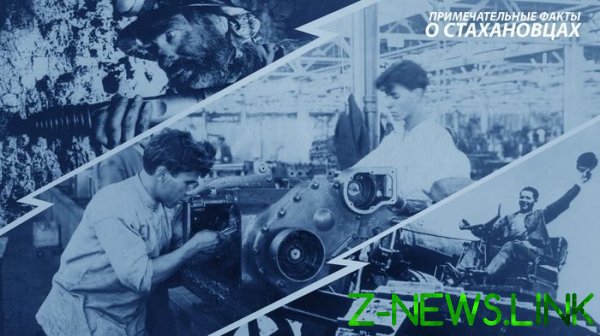
That we, the citizens of modern Russia, known about the Stakhanovite movement and the Stakhanovites? As a rule, different stories, representing workers-Stakhanovites puppets “party functionaries” or materialistic businessmen, or by both simultaneously. If records are inflated, specially prepared and are essentially mindless rush. The situation is presented in such a way that the Stakhanovite movement was a propaganda campaign of the Bolsheviks aimed at stupefying the people, and all working on themselves Stakhanovites mentally abused and even killed them[1]. But in reality, the Stakhanovite movement had a strong mass base in the working class.

Beginning with record A. G. Stakhanov, in the night from 30 to 31 August 1935 produced 102 tons of coal, the Stakhanov movement in the shortest period showed rapid growth in all areas of production. This is well illustrated by the dynamics of growth of workers in the automotive industry immediately after record Stakhanov – in September – the main factories of this industry appeared 184 Stakhanovite[2], in October this number rose to 4,000 people (or 4.3% of the total number of workers in the industry), and in early 1936 in the ranks of the Stakhanovites was already 16 555 persons, representing 23% of the total number of workers of automotive industry[3]. Think about it: in just four months, every fourth worker the automotive industry became a Stakhanovite. Is this not evidence of a mass Stakhanovite movement and a solid base inside the working class. Is this not the most convincing refutation of the myth of the “theatrical” production of the Stakhanovite records.
A contingent from the history vigorously extends the view that the rush and “partnomenklaturnoy” theatrical production Stakhanovite records led to subsequent downtime and also overproduction of individual parts does not have a positive effect on the efficiency of industrial production. Alleged Smith Busygin, adavasi 117 shafts per shift, thus setting a record, then elementary idle, but Ford workers in the US were allegedly carried out every day, its average rate of 100 shafts[4]. In fact, Smith Gorky automobile plant A. K. Busygin 10 September 1935 at a rate of 675 per shift shafts, forge shafts 966 and became thus the founder of the Stakhanov movement in the automotive industry. But on September 13 of that year Gagarin exceeded his record atkova 1001 shaft. The Gagarin began to calm down and soon brought the production to 1146 shafts[5]. But the most remarkable thing is that two years later, in the autumn of 1937 – the rate of production of crankshafts for blacksmiths were not 675, and 1,300 shafts per shift, and records, which established Smiths S. Faustov and A. I. A. Povelikin, was up to 2000 – 2150 crankshaft and more[6]. Those records that critics Stakhanovite “exposed” as a phony and not life, in fact after a short time became the norm for production, i.e., become feasible to the ordinary worker, and that there is evidence of the readiness of the working masses to move on to the higher production and, therefore, the viability of the Stakhanovite records.
In General, the history with the production standards and their revision in connection with the Stakhanovite achievements is quite remarkable. The anti-spread stories about raising standards and reducing costs for workers, which affect all workers. Mass Stakhanovite records some part of the factory managers have tried to use to reduce costs and improve standards. For the beginning of the Stakhanovite movement, it would be a stab in the back: in the initial phase of the movement of the Stakhanovites were just hacked outdated notions about the norms and methods of labour, so conditions for mass use of records have been created, and therefore, the revision of the rules and costs was premature. In October 1935, at the direction of S. Ordzhonikidze, the newspaper “For industrialization” published Dostoevski order of March 13, 1935, on consolidation of norms and pricing rates for one year. By this action the people’s Commissar of heavy engineering publicly warned administrators about the inadmissibility of unauthorized and unjustified revisions of conditions of work[7].
The revision of the workings was made, as planned, until the spring of 1936, and in this regard, the number of workers has decreased. But declined for a while, and since the summer of 1936 began the process of growth in the number of workers, i.e. the workers began to set records relative to the new high standards. In April 1937 was again revised standards, and the number of workers in the period from may to August 1937 fell again, but since August this year, began to rise and blocked the number Stakhanovite 1936. In the figures is as follows: total number of workers of automotive industry on January 1, 1936 amounted to 16 555 people (or 23% of the total number of workers in the industry), on January 1, 1937, amounted to 25 262 people (or 24% of the total number of workers in the industry), and on 1 January 1938 the number of workers reached 28 014 people (or 31% of the total number of workers in the industry)[8].
It turns out that raising standards was accompanied by an increase in the number of Stakhanovites. For the bourgeois mythology is a paradox, because the Stakhanov movement in its view does not have a socio-political grounds, and is a rush and a theatrical performance, but for unadulterated Soviet history is a consistent pattern of developing the productive forces. In addition, the increase in the number of Stakhanovites with simultaneous tightening of the standards indicates a correct policy in relation to rationing: was not forcibly inflated norms, demotivating workers, but was not whiny in front of the workers to the freezing of standards, which would have led to the overspending of the wage Fund and increase the cost of production.
Even reduced the Stakhanov movement to one individual-team records – big mistake. When I tried the “Stakhanov attack” Champions to translate the overall industry in Stakhanov work was completed in the spring of 1936. By this time it had become clear that the plant or factory on a collective Stakhanov work is not to translate breakthroughs in some areas of production that require organizational and technical restructuring of production and the inclusion of broader layers of workers (engineers and supporting production sites) in Stakhanov process. In the quest to become a comprehensive Stakhanov movement through the different stages and acquire different forms of development.
Historian-Marxist V. A. Sakharov in his work about the Stakhanovite movement distinguishes two methods of the Stakhanovite movement. The first method goes back to the beginning of the movement and is characterized by improved organizational and technical measures (rational placement of workers, specialization and division of labor, the release of skilled workers from auxiliary work, reduce equipment downtime and reduce manual labor, thorough preparation for the change, etc., etc.) and is accompanied by the generation increase in 2,5 – 3 times.
The second method went beyond the improvement of production and based on a radical change in the technology of production. First, it was used in mechanic shop Gas die G. I. Maslennikov. Dostoevskii processing time stamp for the blacksmith’s hammer was 65 hours on a single stamp. On the first of the Stakhanovite method it was possible to halve the processing of the stamp, and the processing time amounted to 35 hours. In the spring of 1936, Maslennikov, using the second method, managed to handle the stamp for 10 hours, thus exceeding the Stakhanovite norm 3 times. In the future, working according to the method Maslennikov, a mechanic of that shop A. I. Lyakhov treated the same stamp for 4 hours and 40 minutes, and the Maslennikov 4 hours 35 minutes[9], thereby demonstrating the new horizons of the Stakhanovite movement.
The main task that faced the Soviet industry was to move factories for a permanent job in Stakhanov. And here Stakhanov labor had its stages of development. One of the first major groups that have fallen on the Stakhanovite work became the main conveyors of automotive factories. Successful work related, manufacturing and procurement, departments have established the necessary supply of raw materials for the successful operation of main pipelines. First, the Stalingrad tractor (STZ), and then the Kharkov tractor (HTZ), the plants were transferred to December 1935, their main conveyors to the Stakhanovite work. The results were impressive: the capacity of the conveyors was blocked twice. If in November 1935, major conveyors of STZ and HTZ produced per shift for 72 cars, then in December, after the transition to Stakhanov methods of work, production line of per shift went for 150 tractors[10]. The growth in production of tractors was accompanied by a decrease in the number of marriage.
However, the main Assembly line depended on the work of the subsidiary workshops of related factories and transport, and that made impossible a permanent job in Stakhanov. Required widespread adoption of new forms of work. Began to practice transitions factories and industries in Stakhanov day, five days, ten days. Along with the success of such collaboration was accompanied by failures and setbacks. This gave impetus to the search for new forms of mass Stakhanovite work and in the development of effective organizational and technical measures. There have been attempts end-to-end teams, uniting workers of different professions and departments of a plant that has not received its development. Most effective, the most uglinesses time of the Stakhanovite work of the enterprise and covering the greatest number of workers was the method by which adjacent units are technologically connected to each other gradually and was subsequently included in the Stakhanovite work. As a rule, began the Stakhanovite work procurement and support departments, providing the groundwork for the main shops that have connected later. This method was widely used from mid-1937 and the end of the year were the noticeable results. Thus, the Moscow automobile plant them. Stalin (ZIS) of the 130 working days (from 15 July to 10 December) in Stakhanov worked 45 days, and the procuring Department has been 55 business days[11].
Stimulation and support of workers, development of organizational-technical measures and their implementation in production, the constant search for new forms of collective Stakhanov work have borne fruit. Labor productivity in the automotive industry in 1936, increased in comparison with 1935, 14.5%, and in 1937 increased in comparison with the year 1936 8.3%[12]. In the end, GAS was released in December, 1937, 76% more trucks than in 1936, and VMS increased average daily production of trucks by 12%[13]. In General, it is possible to evaluate and enhance the design capacity of the automobile and tractor plants. Thanks to the Stakhanovite movement, it became obvious that the GAS can give products 33% larger than previously thought, ZIS more than 50%, the Chelyabinsk tractor more by 25%, leading giants like Stalingrad and Kharkov plants, could give the product 2 times more than previously planned[14]. While HTZ marriage in the first quarter of 1936, reduced 1.5 – 3 times, and STZ loss of marriage on one tractor in 1936 decreased by 33% compared with 1935, and payments on claims decreased by 58%[15]. It’s safe to say that the Stakhanov movement has ensured robust plans in 1936 and 1937 and contributed to the implementation of the five year plan in four years.
History of the Stakhanov movement is not limited only to the establishment of a separate production records, workers made a significant contribution to the growth of the wealth of the Soviet Union, in strengthening its defense capability. It is quite clear that such contributions should be encouraged, but fans of the “market” economy believe otherwise. When the capitalist exploiting the worker, enriched, appropriating surplus product, the bourgeoisie considers it a fair reward for entrepreneurial talent, but if the Soviet work, grinding away, delivered by quality products, then its corresponding financial reward for this labor is estimated by the bourgeoisie as unfair. In this case, the bourgeoisie accuses the workers of self-seeking and greed, trying to oppose the workers-Stakhanovites the rest of the workers.
The bourgeoisie would very much like to Soviet authorities 30 years spent antirabique Khrushchev’s policy of the early 60-ies, reducing wages by raising standards. But in the Stalinist period did have and outstanding work, many times overlapping standards, receive a decent financial reward. In addition to high wages in connection with repeatedly ahead of the norm, Stakhanovite material encouragement and other funds. Smith Busygin a month after his record received from the factory a separate apartment with full furnished. The workshops were formed of large cash funds to reward Stakhanovite[16]. In November 1935, on the ZIS 100 Stakhanovites received a new living space, and at the Stalingrad tractor to 1936 in new apartments have driven 60 Stakhanovite. The Stakhanovites were issued irrevocable loan housing repairs and long-term concessional loans for construction of individual houses. Only one Gas for the construction of individual houses 200 workers were allocated 1.5 million rubles. In 1937, the Gas has 800 workers received a living space in new homes. The most notable overachievers, such as Gagarin, Faustov, Maslennikov received from the factory cars[17].
The bourgeois propagandists claim that the workers hated the Stakhanovites because they were enriched, and the rest in poverty. But is it? By the end of 1935, when the Stakhanovite movement was just beginning, and the standards were still Dostoevskii, the percentage of workers not performing standards were different plants 10 to 21% and even briefly increased to 18 – 40% after the increase of production standards. But in 1937, after re-raising standards, the proportion of workers not performing standards, was only 5 – 14%. Note that the rules of 1937, increased in comparison with 1935 on a 40 – 50%, and the number of workers not performing standards, has decreased by half. This demonstrates the increased abilities of the entire mass of the workers, the Stakhanovites became a landmark in labor, and a peculiar locomotive widespread increase productivity. We see that the majority of the workers was with workers and not separated themselves from the Stakhanov movement and the discontent of the workers were able to spread only among a narrow group of backward workers. Of course, that the Stakhanov movement has overcome a lot of difficulties, including the resistance of the working class, and it is quite natural for the innovative process. But also of course the fact that the dissatisfaction of the Stakhanovite movement and the resistance it provided a small layer of the undeveloped, backward workers. Ridiculous to imagine the working class as a homogeneous mass, on the contrary, working in the development of a heterogeneous in its ranks the working class has both advanced and backward groups. Of course that Stakhanovites were advanced layer of the working class, its most advanced and conscious part, and what this advanced interlayer has managed to lead the working class and lead him, a historical fact.
* * *
In conclusion, we note several patterns of the development of socialist productive forces, which revealed the Stakhanov movement.
First, the Stakhanovite movement that emerged from the bottom of the working masses, demonstrated that under socialism intensively developed not only the technical productive forces, but also intensively developing the most important productive force – man. It is important to note that, in contrast to capitalist intensification of production, the socialist intensification (i.e., the Stakhanovite movement) moved not by the way of introduction of sweatshop system of labor, and by way of introduction of scientific organization of labor. If the top capitalists impose on workers excessive work pace, while seeking to simplify the production operation, the worker, turning him into a “screwdriver” and thus AutoPlay it even more, when the Stakhanovite movement the workers themselves, using their practice and their intelligence, have found flaws and bottlenecks and improved them, thus developing their skills even more.
Second, the Stakhanov movement showed that even for dedicated workers financial incentives is crucial not to neglect this factor of motivation under socialism and it is impossible to rely solely on the consciousness of the workers. A material interest is a powerful stimulus to productivity under socialism, but at the same time, is not exhaustive and has limitations. Solely on the basis of the material is essential to the sustainable and lasting development of the main productive forces and, consequently, of the socialist economy. It would be correct to say that the financial interest is foreign or a first incentive of the worker in its activities to go beyond the established framework. Material interest not provided and could not provide the continuous development of the Stakhanov movement, it needed an even more substantial and significant factor. And this factor was the participation of workers in breaking the old and creating the new production process and, hence, a more active and weighty part in the industrial life, and thus, ultimately, participation in the management of production. The Stakhanov movement as a process of development of socialist productive forces could not develop spontaneously and by gravity: it required skilled leadership, which was the proper combination of material incentives and the involvement of workers in managing production. And here we come to the third important fact, which revealed the Stakhanov movement.
Thirdly, experience in the implementation and development of the Stakhanov movement has shown that without government support, without care and assistance from above, the Stakhanovite movement, despite its mass base, would not have lasted a month and certainly would not have received such a development and application. Since the main guiding force of the Soviet state was the Communist party that the Bolsheviks were carrying the brunt of responsibility for the support and implementation of the Stakhanovite movement in the national economy. The Communist party did a tremendous amount and difficulty of work in promoting the Stakhanovite, and modern Communists this experience, along with experience of the October revolution, is an invaluable storehouse of knowledge.
IV. Yakuts
NOTES:
[1] – https://russian7.ru/post/pochemu-v-1935-godu-v-sssr-stali-ubivat-sta/ [2] V. A. Sakharov. The origin and development of the Stakhanov movement, p. 115. [3] – ibid., p. 90; 93. [4] – https://russian7.ru/post/pochemu-v-1935-godu-v-sssr-stali-ubivat-sta/ [5] V. A. Sakharov. The origin and development of the Stakhanov movement, p. 32. [6] – ibid., pp. 103-104. [7] – ibid, pp. 36-37. [8] – ibid., pp. 91-94. [9] – ibid., pp. 78-79. [10] – ibid., p. 82. [11] – ibid., p. 87. [12] – ibid., p. 100. [13] – ibid. [14] – ibid., p. 104. [15] – ibid., p. 101. [16] – ibid., p. 33. [17] – ibid., p. 50; 59-60.© 2020, paradox. All rights reserved.





